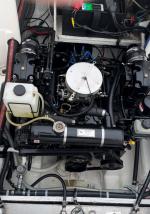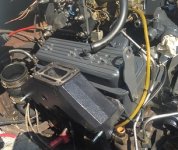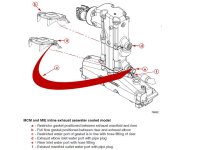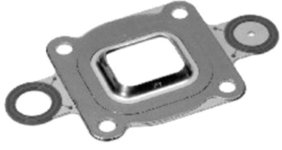Hey Gang,
My boats being a boat again and would like to get some opinions. I’ve recently installed a new rebuilt engine. I reused the old risers and manifolds since they were less than two years old. They looked ok other than a gasket leak which killed the previous motor. The gasket surfaces were machined and cleaned up nice but it’s still developing an external leak at the gasket. Thinking it was a gasket issue I replaced them again, this time with the BARR ones which they recommend sealing with aviation gasket sealer, unfortunately there still leaking.
I’m over it at this point and would like to update them with the new style dry joints. Is it’s possible to swap out my wet style manifolds and risers with the newer dry joint type for my 4.3 Vortec engine. The boat currently has 3 inch spacer blocks with a 7 degree wet style riser. The research I’ve done, it seems possible but it gets a bit confusing with the 3 inch spacer blocks. If I buy the 7 degree dry joint riser, manifold and 3 inch blocks will it be a direct replacement? Are there any pros/cons that I should be aware of if I do make the swap?
Addition information about the engine in question,
It’s operates in SoCal Saltwater, it has a half closed cooling system and the engine number falls in this range - 4.3L (GEN +) (4BBL) Reman - 1G400000 & Up
My boats being a boat again and would like to get some opinions. I’ve recently installed a new rebuilt engine. I reused the old risers and manifolds since they were less than two years old. They looked ok other than a gasket leak which killed the previous motor. The gasket surfaces were machined and cleaned up nice but it’s still developing an external leak at the gasket. Thinking it was a gasket issue I replaced them again, this time with the BARR ones which they recommend sealing with aviation gasket sealer, unfortunately there still leaking.
I’m over it at this point and would like to update them with the new style dry joints. Is it’s possible to swap out my wet style manifolds and risers with the newer dry joint type for my 4.3 Vortec engine. The boat currently has 3 inch spacer blocks with a 7 degree wet style riser. The research I’ve done, it seems possible but it gets a bit confusing with the 3 inch spacer blocks. If I buy the 7 degree dry joint riser, manifold and 3 inch blocks will it be a direct replacement? Are there any pros/cons that I should be aware of if I do make the swap?
Addition information about the engine in question,
It’s operates in SoCal Saltwater, it has a half closed cooling system and the engine number falls in this range - 4.3L (GEN +) (4BBL) Reman - 1G400000 & Up

























